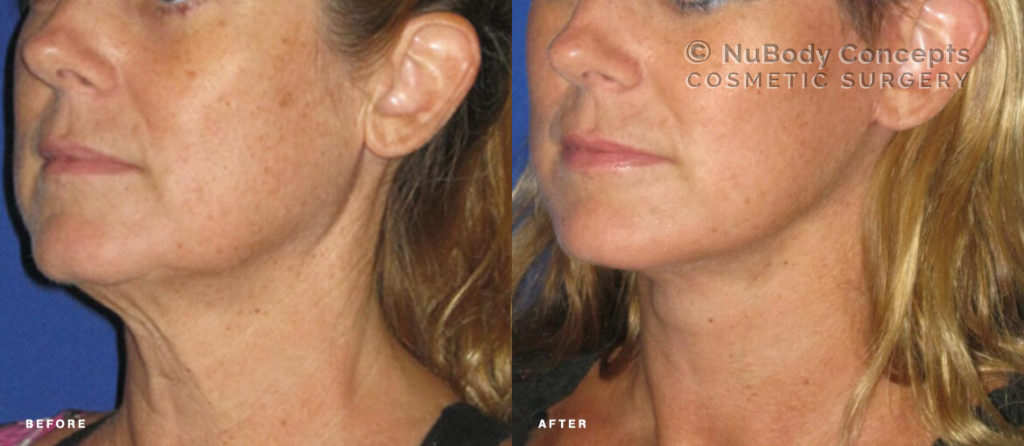
Medically reviewed by Dr. John Rosdeutscher – Written by Sine Thieme
Is a Facelift Safe?
Overall, the risks associated with facelift surgery are relatively low – especially in this day and age when general anesthesia is no longer used for most plastic surgeries. Of course, not all risks can be eliminated. As with any cosmetic surgery procedure, you will have to decide whether the benefits of a facelift outweigh the risks.
Prior to your surgery, your doctor will ask you to sign an “informed consent” document that outlines all known facelift complications and risks. With the help of our NuBody Concepts Cosmetic Surgery staff in Nashville and Memphis we have “translated” this document into an easy-to-understand summary below.
Minimizing Facelift Risks
Before we get into specific risks of facelift surgery, remember that severe complications from a facelift are rare, especially if you are in good health and follow all instructions from your plastic surgeon.
Below are several things you can do to minimize the risks from a facelift and ensure a safe procedure:
- Choosing a Surgeon: Make sure you select a board-certified plastic surgeon who has the required expertise with facial rejuvenation.
- Medical history: Answer all questions about previous and existing medical conditions, past surgeries (cosmetic and otherwise), complications from surgeries, smoking, and/or drug and alcohol use.
- Medications: Disclose all prescription and OTC medications, vitamins, and supplements you currently use. Your plastic surgeon will ask you to discontinue certain medication at a set interval before the procedure. It is important to follow those directives to ensure a safe procedure.
- Pre-Op Instructions: Faithfully follow all other pre-op instructions given by your surgeon, such as when to stop the intake of food on the day before the procedure.
- After-Care: Faithfully follow all post-op instructions including wound care, compression garment, and resumption of exercise. Also arrange for help during recovery, especially if you have small children. Call the doctor immediately if you have any concerns or adverse reactions that are not listed in your post-op instructions.
- Follow-Up: Go to all your follow-up appointments scheduled by the surgeon to ensure that your recovery is going as planned.
Risks from a Facelift
The risks and potential safety concerns of a facelift can be divided into risks that are specific to a facelift, risks that accompany any surgical procedure, and increased risk factors due to the patient’s prior health history.
First, we discuss the risks specific to facelift surgery:
Hair Loss
It is possible to experience hair loss in areas of the face where the skin was elevated during surgery – i.e. where incisions are placed. In more severe cases, this can result in larger hairless areas and/or an irregular hairline. In some cases, it can in effect lead to the entire loss of sideburns for male patients. It is possible to conceal such loss by favoring certain hairstyles. Unfortunately the occurrence of this is not predictable.
For many patients, hair loss after a facelift is not a problem. Should it occur, it can be resolved with a hair transplant that moves follicles from a donor area to the affected area.
Nerve Injury
Motor and sensory nerves may be injured during any surgical procedure, and this is also true for a facelift operation. This can lead to weakness or loss of facial movements as a result of your surgery, resulting in an uneven facial expression.
Such nerve injuries typically only cause temporary loss of facial movements and feeling and resolve in a few weeks or months, but in rare cases these can be permanent.
Skin Loss
In rare cases a face lift can interrupt the blood supply to facial tissues, leading to skin loss. This can be treated using medications and wound care. It can also be addressed later with a scar revision treatment.
Scarring
A surgical facelift, as opposed to a non-surgical facelift, does leave permanent scars. However, these are typically concealed by the hairline as well as the natural contours of the face around the ear. In some cases – but rarely – incisions can produce raised, red scars. Scar revision treatments are typically effective in minimizing scar visibility.
General Risks of Surgery
While the above risk factors are specific to facelift surgery, there are also general risks inherent to any surgery:
Anesthesia Risks
A facelift is typically performed under local anesthesia and IV sedation. It does not require general anesthesia. All anesthesia carries a certain risk, even though complications from anesthesia during a facelift are rare. There are other risk factors that may present increased anesthesia risks, such as smoking or obesity (more on that below).
Bruising & Swelling
Some bruising and swelling is to be expected after any surgical procedure. Some patients may experience it more acutely than others. It typically resolves after a week and can be kept to a minimum with a combination of cold compresses, elevation, and Ibuprofen. Persistent swelling or chronic pain is rare but can occur. Patients who develop a hematoma (collection of blood under the skin) within 24 hours of surgery should contact their doctor immediately to have this surgically addressed.
The best way to keep swelling at bay is to follow your surgeon’s post-op instructions and wear the compression garment if one is prescribed. Most patients are able to show their face in public after 7 days. Please note that this does not mean your recovery from the surgery takes that long. You are free to go about your daily activities within a day or two of your procedure, but the so-called social recovery will take longer depending on your bruising and swelling.
Other Surgical Risks
The following complications can arise from a surgery: risk of infection, fluid accumulation, poor wound healing, blood clots, deep vein thrombosis, cardiac complications or pulmonary thromboembolisms or pulmonary edema, and damage to deeper structures such as nerves, blood vessels, muscles, lungs and abdominal organs.
These risks are exceedingly rare and not facelift-specific, but you will be informed about them in your signed consent document.
Increased Risk Factors
The best way to ensure a safe facelift procedure is to be a low-risk patient from the outset. The following are factors to look out for that might increase your surgical risks:
Smoking
You are at a greater risk for significant surgical complications if you are a smoker, use tobacco or nicotine products such as patches, gum, or nasal spray, or, to a lesser extent, if you’ve been exposed to secondary smoke. Such complications include skin dying, delayed healing, and additional scarring. Smoking can also have a negative effect on your recovery from anesthesia. Again, a facelift doesn’t require general anesthesia, and the recovery from IV sedation carries very low risks. However, smoking does increase those risks.
It is simply best if you don’t smoke, period. However, if you are a smoker, you can improve your outcome if you give up smoking at least six weeks before the procedure. You will be asked to truthfully disclose your smoking habit in your signed consent document.
Blood-Thinning Medications or Supplements
If you are taking any medications or supplements that thin the blood, you will need to stop taking those a certain period before your procedure, as disclosed in your pre-op instructions given by the cosmetic surgeon. He or she may also ask for a letter from your cardiologist clearing you for the procedure.
Blood-thinners affect your blood’s ability to clot, preventing proper wound healing. They can also increase the risk of hematomas after surgery. Medications on this list include blood thinners (Coumadin, Plavix, others), aspirin, nonsteroidal anti-inflammatory drugs (NSAIDs), ginseng, Ginkgo, fish oil and others.
Medical Conditions
Patients who have a medical condition that prevents blood clotting cannot have a facelift or other surgical procedure. Other conditions can increase the risk of poor wound healing or even heart complications, such as high blood pressure or diabetes.
Weight Loss or Gain
Weight loss or gain is not an inherent problem, but if you have a history of substantial weight fluctuations, you may not get the best outcome from your facelift. If you were to lose or gain a lot of weight after your surgery, the shape of your face or condition of your skin would be affected, which could alter the result.

We hope that we’ve given you a better understanding about facelift safety and risks. Please don’t hesitate to contact us if you have any other questions.
If you are ready to get started, use the pink button to schedule a consultation with our board-certified plastic surgeon in Nashville or Memphis.












